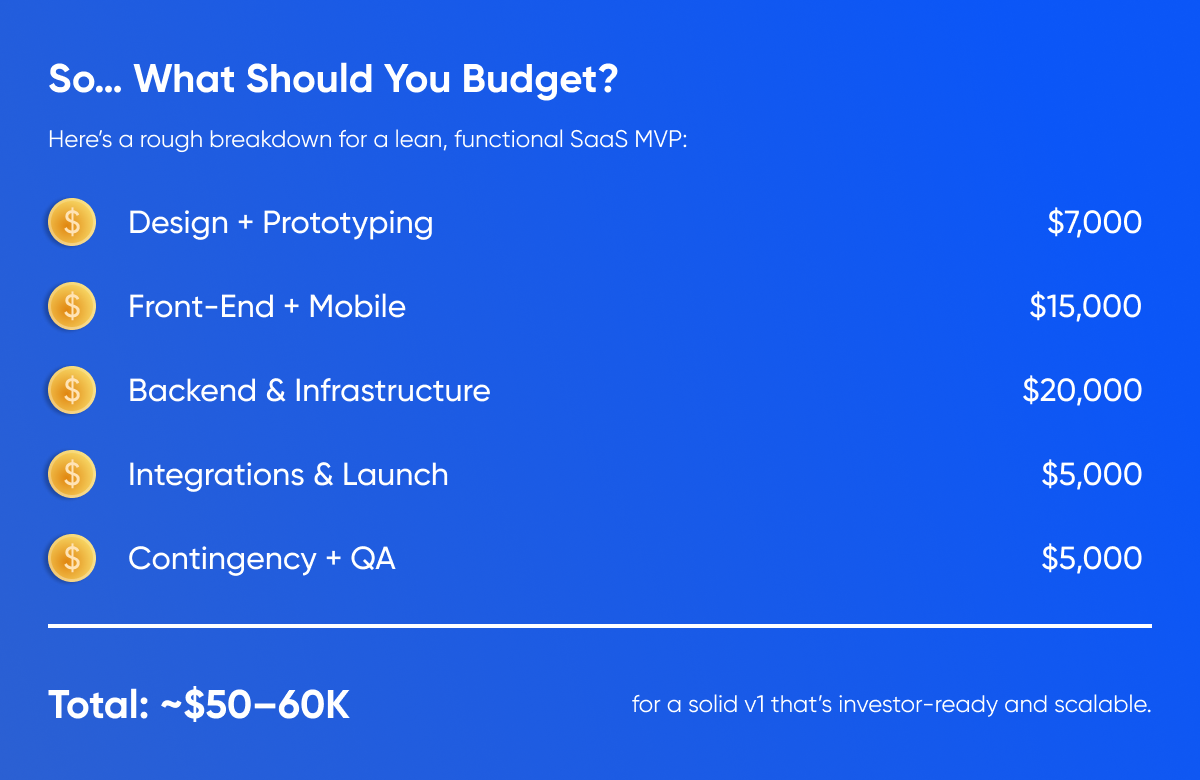If you're building a SaaS startup, budgeting is one of the first real strategic decisions you'll face. It determines what kind of product you can launch, how quickly you can iterate, and how far your runway will stretch before you need to raise again. But understanding what it actually costs to build a SaaS product in 2025 — not just in dollars, but in time, trade-offs, and hidden infrastructure — is trickier than ever.
We work with startups at every stage of the journey at Movadex — from napkin-stage prototypes to post-Series A rebuilds. And if there’s one thing we’ve learned, it’s this: cost isn’t just about what you pay for. It’s about how you build — and who you build with.
Let’s break down the real costs of SaaS development in 2025, so you can budget with clarity and build with confidence.
The MVP Phase: $25,000–$80,000
This is the “prove-it” stage. You’re not building every feature. You’re building just enough to validate that your product solves a real problem for real people.
A lean, well-structured MVP typically includes user onboarding, authentication, one or two core flows (e.g., project creation, data entry, dashboard), and basic analytics. Most of these can be built using a modern cross-platform stack like React (for web), Flutter (for mobile), Firebase or Supabase (for backend), and Stripe (for payments).
If you're working with an external team, expect to pay around $50–75/hour for quality dev and design talent. This gives you a stable MVP in 4–8 weeks. A smaller scope, solo-founder project could start as low as $25K with a tight team or solo agency partner.
Trying to go cheaper than this often leads to unscalable, buggy products you’ll have to rebuild — and that will cost more down the line.
UX/UI Design: $5,000–$15,000
Founders often undervalue design — but in SaaS, UX is retention. Confusing flows or inconsistent visuals can kill adoption, even if the functionality is solid.
You’ll need wireframes, a clickable prototype, a visual design system, and final UI assets. A solid UX/UI partner or design team can do this in 2–4 weeks. If you’re working with a dev studio like Movadex, design and dev can happen in tandem, which accelerates delivery without skipping polish.
Design isn't about making things pretty. It's about making sure users can get value without friction — and that saves you hours in support, onboarding, and churn mitigation.
Backend Architecture: $10,000–$30,000
If your product is more than a simple front-end form, your backend will carry most of the technical load.
Using BaaS (Backend-as-a-Service) tools like Firebase, Supabase, or AWS Amplify can dramatically reduce cost and time, especially in early stages. These tools handle auth, storage, APIs, and scalability — all without you needing a DevOps team.
But if you’re building something with complex logic, real-time data, or multi-tenant architecture, you’ll likely need a custom backend (Node.js, Django, Rails) and cloud infrastructure (AWS, GCP, Azure).
The more configurable your product needs to be, the more planning and modularization your backend will require — and the more budget you’ll need to allocate here.
Integrations and Payments: $2,000–$10,000
SaaS tools don’t live in isolation. You’ll likely need Stripe (or Paddle) for billing, a CRM like HubSpot or Segment integration, perhaps an email system like Postmark or SendGrid, and maybe even Slack, Zapier, or API integrations for enterprise clients.
Each integration can add a few days to your dev timeline. Plan for this early. Don’t treat integrations as “plug and play” — they still require testing, monitoring, and ongoing maintenance.
Ongoing Maintenance: $2,000–$5,000/month
Once your MVP is live, you’ll need to monitor performance, fix bugs, deploy updates, and support your users. Even if your app runs smoothly, expect to spend 10–15 hours/month on updates alone.
If you’re working with an agency or freelance team, you might negotiate a monthly retainer. If you have an in-house dev, that’s their part-time job. And if you have paying users — it’s your job to keep things reliable.
Add to this the cost of cloud hosting, third-party tools, and analytics platforms. For most small SaaS apps, infra + tools will run around $200–$1,000/month.
Hiring vs. Outsourcing: A Strategic Choice
Building in-house gives you long-term ownership and control, but comes with overhead: hiring, payroll, benefits, and team management.
Hiring a small studio or freelance team can reduce burn early on and get you to market faster — as long as you choose a team that builds with scalability in mind. Ask for code samples, architecture diagrams, and post-launch support plans.
Many of our clients at Movadex start with an outsourced MVP, then bring in-house talent once they’ve found product-market fit and are ready to scale.

If you’re planning to raise, aim to spend no more than 10–15% of your round on v1 development. Preserve runway for sales, customer success, and marketing — because a great product without growth is just shelfware.
Final Thought: Build Like You’ll Scale, Budget Like You’ll Learn
Don’t spend six figures before you have users. But don’t underinvest in the systems and experience that will keep those users around.
The smartest founders know that early SaaS development isn’t about building everything — it’s about building the right things well enough to grow.
At Movadex, we help early-stage startups scope lean, scalable SaaS products with clarity — and bring them to market with speed, polish, and growth baked in.
If you’re budgeting your first SaaS build, make sure you’re not just buying code. Make sure you’re investing in momentum.




